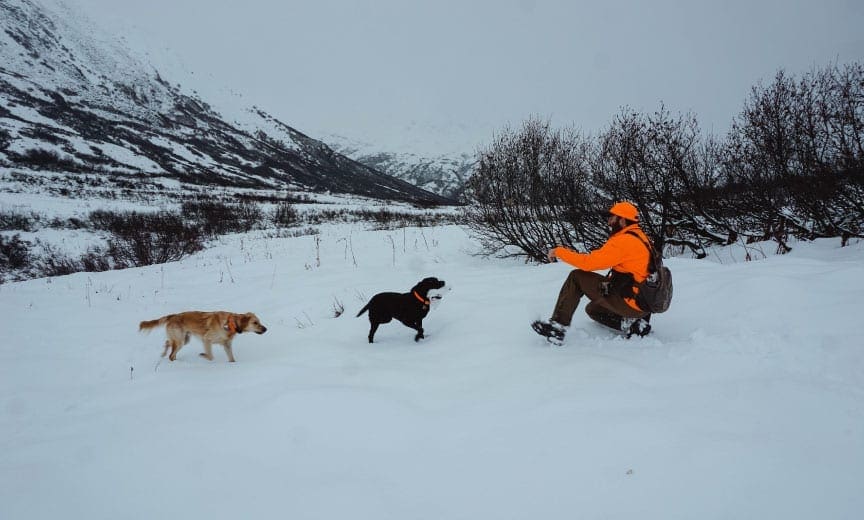Are Ptarmigan the Quail of Alaska?
With three species of ptarmigan in Alaska and their wide availability they may just be the quail of the North.
For an upland hunter the mention of Alaska conjures up dreams of an upland hunting Mecca. Public land to hunt farther than the eye can see. Regions only accessible by river boat or bush plane. Daily bag limits that would seem incredible to those unfamiliar with its vastness, and a species variety that few other places can rival. If you were to take a poll of upland hunters and ask them what bird they most desire to chase in the last frontier, you would likely get one uniform answer: ptarmigan.
The ptarmigan stands as an iconic representative of Alaska’s unique wildness. Although Alaska is also home to ruffed grouse, spruce grouse, sharp-tailed grouse, sooty grouse, and even snipe, an uplander can find all of those birds in the lower 48 with enough ambition. If you want to hunt ptarmigan though, a bird synonymous with mountains and arctic landscapes, Alaska is the place.
Read: Upland Hunting by Back Country Skis
Ptarmigan are a wild bird that live in incredibly wild places. Although similarities can be drawn to other upland pursuits, a ptarmigan hunt in Alaska is an experience unique unto itself. As a bird, they are uniquely suited to surviving in their world and avoiding us in the process. In the autumn season the typical tricks we use as upland hunters to find birds don’t always produce results when searching for ptarmigan.
Finding their food source doesn’t really help as the berries they feed on can sometimes cover the entire landscape like a culinary carpet. Water sources are nearly everywhere as the landscape they inhabit is dotted with natural springs and water trapped from the seasonal snow melt. You are inevitably left with one card to play, and that is to cover as much ground as possible. It’s not uncommon to walk all day for a chance at one flock, and when you do find them you need be on your game. If you have a big running pointing dog then you’ve got the best tool you could have as a flock will hold for a point, giving you time to prepare for the flush. Over the years they’ve earned the nickname “Quail of the North,” and it’s a fitting title despite technically being a grouse species. A single ptarmigan on the wing is not a challenging target, but their main defense lies in your confusion as they explode from a seemingly sparse landscape.

The seasons in Alaska change dramatically fast, and the ptarmigan change with them. They spend summer and fall dressed in mottled plumage, a beautiful and unique camouflage that helps young birds hide from abundant predators. As the snow starts to fall, winter will be fast on its heels and the ptarmigan adapt quickly. They shed their summer and fall colorings, turning nearly solid white to hide themselves in their freshly snow covered landscape.
It’s at this point in the season that ptarmigan hunting can be at its best. The birds must begin to abandon their remote strongholds as the snow pack accumulates, and their need for food and water sources begins to be targetable. When they could have once been anywhere on the mountain, they can now be found in the high elevation valleys and benchtops where they begin to congregate in larger flocks. Although they can be easier to find, bagging them during this time presents an entirely different challenge. Their covey-rise nature can present incredibly difficult shooting. Focusing on a white bird, with a white backdrop, is challenging for even the keenest eye. Having a flurry of them spring forth from a snowy bank can have you trying to sort out what oftentimes looks like a flurry of white shadows on snow.
If you ever have the chance to make it to Alaska, a ptarmigan hunt needs to be on your list. As an upland hunter’s bucket list trip there are many experiences to be had up here, but none more iconic than the ptarmigan. There are three different species you can encounter: willow, rock, and white-tailed ptarmigan. Each has its own virtues, nuances, favorite habitat, and it’s not uncommon to encounter a variety on a single hunt. A day afield for them can be a long one, so be sure to pack along lots of water, snacks, and boot leather. If you’ve hunted covey birds before, then you’re as prepared as you can be for when you do find them. And when the dog goes on point make sure your head is in the game. Ptarmigan live in an incredible place, and it can be easy to get lost in the beauty of the moment as they get away.






